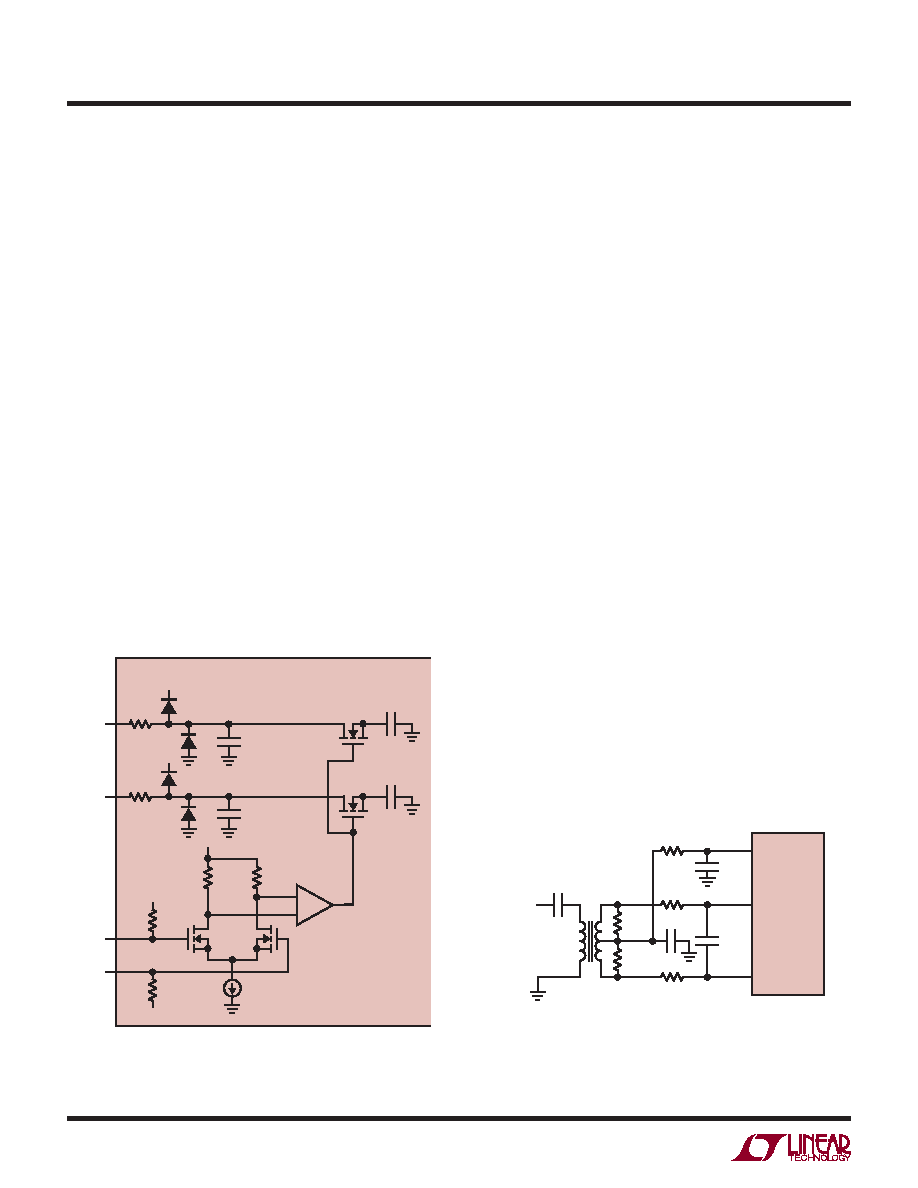- 您現(xiàn)在的位置:買(mǎi)賣(mài)IC網(wǎng) > PDF目錄19024 > DC1620A-J (Linear Technology)BOARD DEMO 65MSPS LTC2142-14 PDF資料下載
參數(shù)資料
| 型號(hào): | DC1620A-J |
| 廠(chǎng)商: | Linear Technology |
| 文件頁(yè)數(shù): | 13/38頁(yè) |
| 文件大小: | 0K |
| 描述: | BOARD DEMO 65MSPS LTC2142-14 |
| 軟件下載: | QuikEval II System |
| 設(shè)計(jì)資源: | DC1620A Design Files DC1620A Schematic |
| 標(biāo)準(zhǔn)包裝: | 1 |
| 系列: | * |
| 相關(guān)產(chǎn)品: | DC890B-ND - BOARD USB DATA COLLECTION |
第1頁(yè)第2頁(yè)第3頁(yè)第4頁(yè)第5頁(yè)第6頁(yè)第7頁(yè)第8頁(yè)第9頁(yè)第10頁(yè)第11頁(yè)第12頁(yè)當(dāng)前第13頁(yè)第14頁(yè)第15頁(yè)第16頁(yè)第17頁(yè)第18頁(yè)第19頁(yè)第20頁(yè)第21頁(yè)第22頁(yè)第23頁(yè)第24頁(yè)第25頁(yè)第26頁(yè)第27頁(yè)第28頁(yè)第29頁(yè)第30頁(yè)第31頁(yè)第32頁(yè)第33頁(yè)第34頁(yè)第35頁(yè)第36頁(yè)第37頁(yè)第38頁(yè)

LTC2142-14/
LTC2141-14/LTC2140-14
20
21421014fa
CONVERTER OPERATION
The LTC2142-14/LTC2141-14/LTC2140-14 are low power,
2-channel, 14-bit, 65Msps/40Msps/25Msps A/D convert-
ers that are powered by a single 1.8V supply. The analog
inputs should be driven differentially. The encode input
can be driven differentially, or single ended for lower
power consumption. The digital outputs can be CMOS,
double data rate CMOS (to halve the number of output
lines), or double data rate LVDS (to reduce digital noise
in the system.) Many additional features can be chosen
by programming the mode control registers through a
serial SPI port.
ANALOG INPUT
The analog inputs are differential CMOS sample-and-hold
circuits (Figure 2). The inputs should be driven differen-
tially around a common mode voltage set by the VCM1 or
VCM2 output pins, which are nominally VDD/2. For the 2V
input range, the inputs should swing from VCM – 0.5V
to VCM + 0.5V. There should be 180° phase difference
between the inputs.
The two channels are simultaneously sampled by a shared
encode circuit (Figure 2).
Single-Ended Input
For applications less sensitive to harmonic distortion, the
AIN+ input can be driven single-ended with a 1VP-P signal
centered around VCM. The AIN– input should be connected
to VCM and the VCM bypass capacitor should be increased
to 2.2μF. With a single-ended input, the harmonic distortion
and INL will degrade, but the noise and DNL will remain
unchanged.
INPUT DRIVE CIRCUITS
Input Filtering
If possible, there should be an RC lowpass filter right at
the analog inputs. This lowpass filter isolates the drive
circuitry from the A/D sample-and-hold switching, and
also limits wideband noise from the drive circuitry. Figure 3
shows an example of an input RC filter. The RC component
values should be chosen based on the application’s input
frequency.
Transformer Coupled Circuits
Figure 3 shows the analog input being driven by an RF
transformer with a center-tapped secondary. The center
tap is biased with VCM, setting the A/D input at its opti-
mal DC level. At higher input frequencies, a transmission
line balun transformer (Figure 4 to Figure 6) has better
balance, resulting in lower A/D distortion.
CSAMPLE
5pF
RON
15Ω
RON
15Ω
VDD
LTC2142
AIN
+
21421014 F02
CSAMPLE
5pF
VDD
AIN
–
ENC–
ENC+
1.2V
10k
1.2V
10k
CPARASITIC
1.8pF
CPARASITIC
1.8pF
10Ω
25Ω
50Ω
0.1μF
AIN
+
AIN
–
12pF
0.1μF
VCM
LTC2142
ANALOG
INPUT
0.1μF
T1
1:1
T1: MA/COM MABAES0060
RESISTORS, CAPACITORS
ARE 0402 PACKAGE SIZE
21421014 F03
Figure 2. Equivalent Input Circuit. Only One of
the Two Analog Channels Is Shown
Figure 3. Analog Input Circuit Using a Transformer.
Recommended for Input Frequencies from 5MHz to 70MHz
APPLICATIONS INFORMATION
相關(guān)PDF資料 |
PDF描述 |
|---|---|
| 1850 | LAMP T3-1/4 MINI BAYONET BASE |
| 89 | LAMP INCAND G-6 S.C. BAYONET |
| CL-927-ELP30-PC | CHROMALIT ELLIPSE LHT SRCE BULB |
| 521-0756 | LED T3 1/4 MINI PANEL BAYO 14V |
| BSO301SP H | MOSFET P-CH 30V 12.6A 8DSO |
相關(guān)代理商/技術(shù)參數(shù) |
參數(shù)描述 |
|---|---|
| DC1620A-K | 功能描述:BOARD DEMO 40MSPS LTC2141-14 RoHS:是 類(lèi)別:未定義的類(lèi)別 >> 其它 系列:* 標(biāo)準(zhǔn)包裝:1 系列:* 其它名稱(chēng):MS305720A |
| DC1620A-L | 功能描述:BOARD DEMO 25MSPS LTC2140-14 RoHS:是 類(lèi)別:未定義的類(lèi)別 >> 其它 系列:* 標(biāo)準(zhǔn)包裝:1 系列:* 其它名稱(chēng):MS305720A |
| DC1620A-M | 功能描述:BOARD DEMO 125MSPS LTC2145-12 RoHS:是 類(lèi)別:未定義的類(lèi)別 >> 其它 系列:* 標(biāo)準(zhǔn)包裝:1 系列:* 其它名稱(chēng):MS305720A |
| DC1620A-N | 功能描述:BOARD DEMO 105MSPS LTC2144-12 RoHS:是 類(lèi)別:未定義的類(lèi)別 >> 其它 系列:* 標(biāo)準(zhǔn)包裝:1 系列:* 其它名稱(chēng):MS305720A |
| DC1620A-O | 功能描述:BOARD DEMO 80MSPS LTC2143-12 RoHS:是 類(lèi)別:未定義的類(lèi)別 >> 其它 系列:* 標(biāo)準(zhǔn)包裝:1 系列:* 其它名稱(chēng):MS305720A |
發(fā)布緊急采購(gòu),3分鐘左右您將得到回復(fù)。